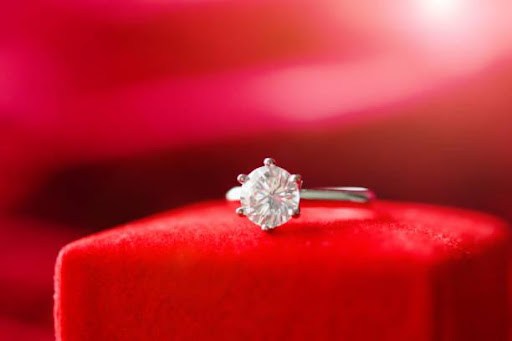
The diamond ring is one of the hardest pre-proposal decisions. Success requires balancing weight and value. A half-carat diamond is affordable and covers the ring finger. In many countries, engagement rings have half-carat diamonds.
This guide covers buying a half-carat diamond ring. We'll explain how diamond dimensions change based on shape and quality. Read on to learn about half-carat diamond rings.
Carats measure diamond weight, not size. Stone shape affects proportions and size. Diamonds with a lower profile cover more of your finger. Half-carat round-cut diamonds measure 5 mm. A round diamond with a deep cut appears smaller from a distance.
The elongated diamond looks bigger. Marquise and pear cuts' sharp tips cover more area. Emerald's weight is on its sides. Deeper cuts shine more than flat ones.
Sparkling a diamond doesn't require sacrificing its shape. Thin bands help define round-cut diamonds set in a halo. A three-stone setting can enhance a half-carat diamond's appearance.
The 4 C's rule is well-known. With limited funds, product features can be compromised. To appreciate a diamond's appearance, you must know its most important characteristics.
Cut is a diamond's most valuable feature. A flawless color can't hide a poor cut. Even small inclusions can distinguish a good cut from a bad one. Don't skimp on a diamond's cut. A brilliant diamond appears larger and hides flaws.
Color cannot be generalized. Above H, a diamond's color grade is whiter. If you prefer warmer tones, choose J or K. The surrounding precious metal affects the stone's color. Lower-grade white gold and platinum are forgiving.
Which setting is best for a half-carat diamond?
A properly set half-carat diamond can look larger. Classic rings have four or six prongs. Four-prong settings expose less stone but are less stable. A diamond looks bigger with fewer prongs.
Bezel settings define a diamond's outline. Metal that follows the stone's contours highlights its shape. Bezels will secure the stone. Bezel settings require a specific band to make a half-carat diamond appear larger. A wide bezel band with small diamonds may look as good as a large diamond.
Bandwidth is crucial. Wide bands obscure half-carat diamonds. Narrow bands are best. Pave-set accent diamonds on the band create the illusion of a larger center stone.
Using three-stone ring settings in jewelry can define or ruin a half-carat center diamond. Smaller diamonds make larger diamonds appear. When placed together, center-stone-sized side stones look unified.
Narrow-banded rings look best on slim hands. Wide fingers may hide a half-carat diamond. Brides with larger fingers can get more carats for less money.
Half-carat diamonds look smaller when resized for wider fingers. A halo setting highlights the center stone and boosts the ring's overall luster. Halo-style rings' uneven weight distribution requires a wider band. Not all split-shank styles have a wide band and delicate look. Our guide explains halo and cluster rings.
Wide-fingered brides prefer thick bezel bands, but they don't work with small diamonds. To highlight the stone, choose a bezel band with engraving or openwork. Consider a ring with a wide band set with smaller diamonds. Even half-carat clusters look better in thick settings.
After choosing the diamond shape and setting, you must understand how diamonds are valued to find the best stone. Weight, cut, clarity, and color affect diamond prices. Always begin with your weight. Price increases are often complicated, not exponential. If a 1 carat diamond costs $7,000, a 2 carat diamond may cost $27,000, not $14,000.
Cut affects a diamond's price. Diamond cut determines fire and brilliance. White light striking a diamond's facets creates "diamond fire" However, not all diamonds have it. GIA's diamond cut grade also considers design and craftsmanship. Ensure cut quality.
Diamond color affects price. Colorless diamonds are rarest and most expensive. Most buyers can't distinguish between D, E, and F colorless diamonds, but this isn't a problem for the industry. Environment affects color.
Clarity is harder to see than color in stones. Larger stones require more care. When working with a limited budget, diamond clarity is sacrificed first.
Not just the 4 C rule affects diamond pricing. Popular sizes and shapes. When other factors are equal, round-cut stones are the most expensive. emerald, oval, and cushion-cut diamonds are mid-priced. Heart-cut diamonds are among the least desired and cheapest.
The certification lab affects a diamond's price. Certification proves a stone's authenticity and quality. AGSL and GIA perform the most accurate analyses. Therefore, a diamond certified by one of these labs will be more expensive. Diamond certifications aren't always reliable. Laboratories should only assess quality, not price.
Global economy affects diamond prices. The economy affects diamond prices. Your proposal won't use rough numbers.
We hope you now know everything about buying a half-carat diamond. Consider the ring's style and diamond's value before buying. Using our ring budget calculator, you can determine how much you can spend. When choosing a diamond, stick to your budget and consider the above factors.
Sell your diamonds with ease with Diamond Registry’s comprehensive approach and vast global industry connections to help you find the best buyer for your diamond fast. Visit www.diamondregistry.com/sell-your-ring to take your first step to fast, easy and reliable way of selling your diamond.
Want to check and calculate diamond per carat instantly? Go to DR’s diamond price calculator www.diamondregistry.com/diamond-price-list/#calc-move-to to know how. Reliable and trusted carat calculator in the diamond industry since!

